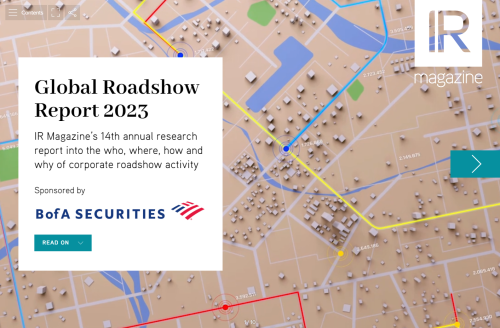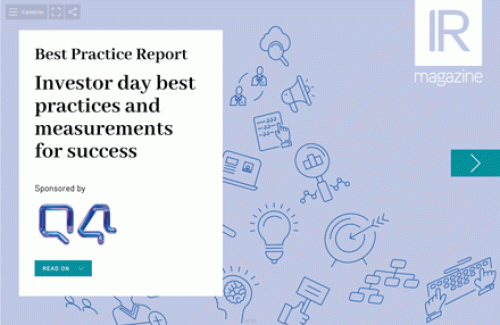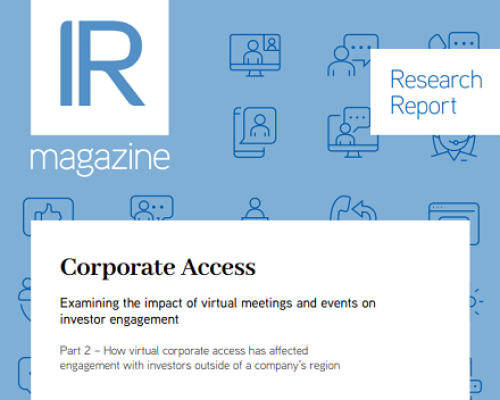Davids Garafolo (CFO) and Smith (IRO), both IR Magazine Award-winners, talk about the financial climate, targetting and managing investors, and their partnership at Agnico-Eagle Mines
Few IR teams put on a better roadshow than the ‘two Davids’ of Toronto-based Agnico-Eagle Mines. At the IR Magazine Canada Awards 2009, David Garofalo received the award for best IR by a chief financial officer and David Smith, head of IR, was a finalist for best large-cap IRO. Here they name the three hardest things about each other’s jobs.
Smith on his CFO
1: Explaining esoteric tax laws, among other things, to analysts. ‘Dave has to understand the mining industry all the way through – exploration, mine building, mine operation, plus the financial side – and explain it to analysts and investors. But I’ve also heard him answer very specific tax questions from analysts who are building and maintaining detailed models. That’s not easy. In November 2005 we purchased Riddarhyttan Resources, which operates mines in Finland and is listed in Sweden. Dave has to understand and explain Swedish securities law and Finnish tax laws and how they relate to a Canadian-domiciled company that is an SEC registrant.’
2: Managing complex systems and lots of people. ‘We now have at least 50 finance people globally to manage. We’re in Canada, the US, Finland and Mexico. Managing and controlling the systems and the people from all of those international locations is a lot of work – and Dave has to understand Mexican tax laws now, too!’
3: Planning in an uncertain financial climate. ‘On a daily basis, Dave’s managing a company that has inputs way beyond our control, like the price of gold or currency rates. Our largest sensitivity is the Canadian dollar, which is something we clearly have no influence over.
‘It’s very challenging planning for the next 10 years when you really don’t know what the input and the cost sides are going to be over long or even short periods of time. Last year we spent $900 mn on capital projects, while this year we’re spending $450 mn.
‘One of the challenges brought on by the crash last October was that we had a very large capital program outstanding and it required money, but nobody knew where the bottom was. We did do a $280 mn equity issue in November, and that kind of bullet-proofed the balance sheet.
‘I think, overall, that this is probably Dave’s greatest source of stress: having to plan how many inputs there are going to be. You have to make assumptions, but you also need to leave yourself a margin of error. Dave becomes uncomfortable when we have less than $100 mn in the bank – and I get uncomfortable whenever Dave gets uncomfortable.’
Garofalo on his IRO
1: Explaining esoteric mining data, among other things, to investors. ‘Dave has to bridge the gap between technical people and the investors, who are not necessarily technically oriented, and he has to do it in a timely way. We spend $60 mn to $70 mn a year on exploration, drilling to find new gold reserves, and ultimately converting that into productive ounces. We get a lot of data over the course of the year. We have to organize it, interpret it and communicate it.
‘We did an exploration update in late February. Dave spent a lot of time just getting it into an intelligible and understandable format, and interpreting what it meant for potential growth in gold reserves. It probably took him four or five months.’
2: Managing panicky investors. ‘Dave gets a lot of inbound calls, particularly from the retail side. When the stock moves up or down in a very volatile way, his phone lights up. Institutional investors are sophisticated, but a retail investor will call if the stock is down a dollar.
‘This past fall was difficult because there was indiscriminate selling across all the asset classes including gold. Hedge funds were imploding and they had to undertake a wholesale liquidation of all their investments. We had to deal with a lot of panic calls, particularly on the retail side, even though our story is fundamentally sound. Dave was never haggard, though. He handles pressure very well; he’s always on.’
3: Targeting new investors. ‘It’s always a very time-consuming exercise. Dave speaks to salespeople and analysts frequently. He’s always looking for investors who should be in our stock, or who are underweight in gold. Last year we had 350 one-on-ones with institutional investors – that’s a massive undertaking. We have to be in front of as many investors as possible and make sure they maintain an interest in the stock.’










